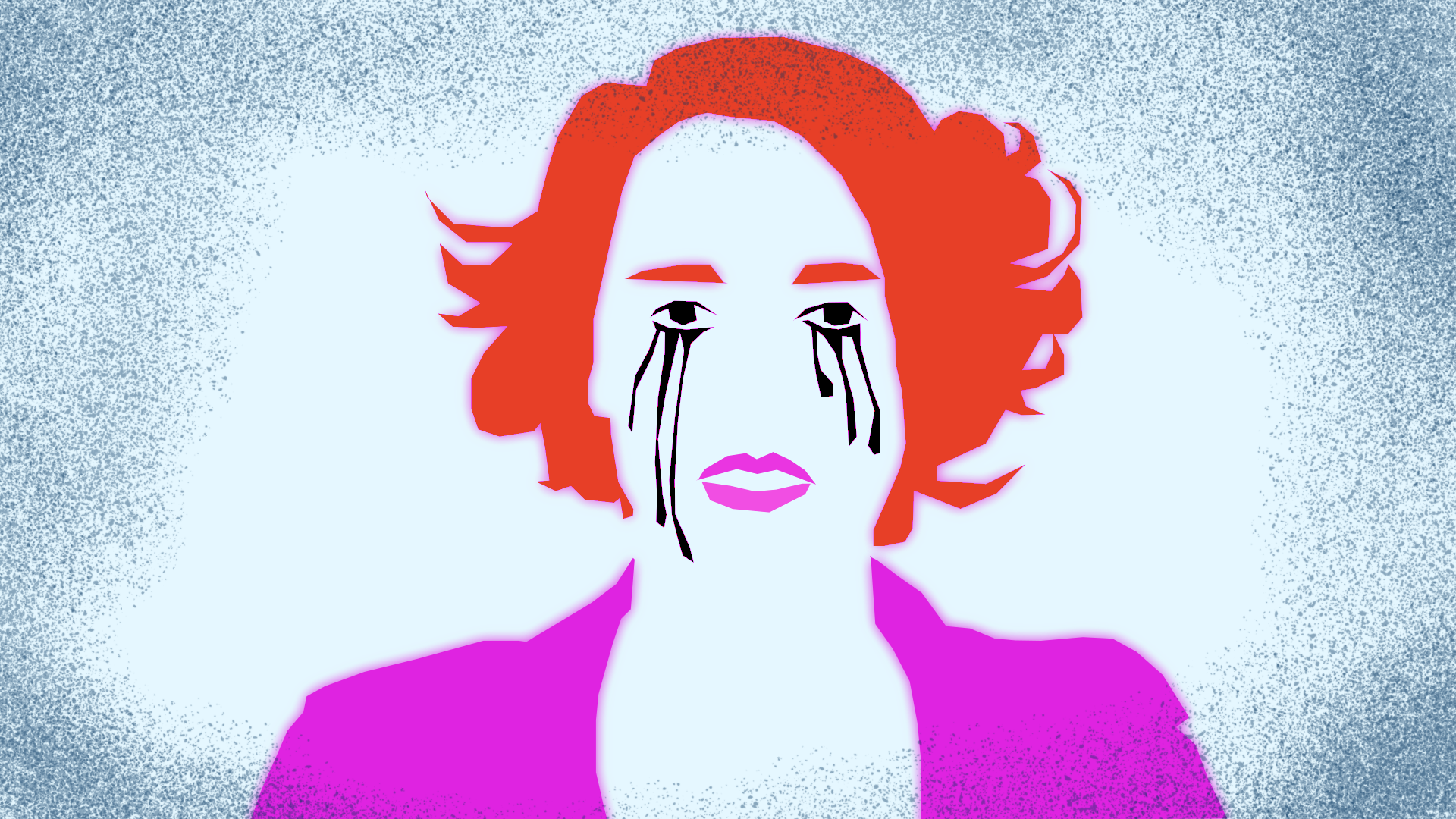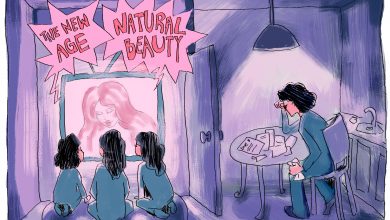Dissociative Feminism: A New Era of Romanticizing Women’s Mental Health Issues

Design by Lauren Cramer
Image description: Illustration on a light blue background featuring the head and shoulders of a person with short red hair and a bright pink jacket. The person has mascara running down their face from crying.
Maybe you’ve had the feminine urge to give up, or ruin your own life. Perhaps you’ve seen people entering their “fleabag eras.” Most of this is found in TikToks and Tweets expressing relatable, or at least cathartic ideas about leaning into feminine misery—like feeling the prettiest when you cry in mascara, or wallowing in heartbreak at the hands of some deplorable man. None of this is necessarily new; women and femme people have been miserable for centuries.
Many of us may remember being on Tumblr from the years 2012-2015 with a kind of nostalgic fondness for our youths that is frankly unwarranted. If you were fortunate enough to not have experienced this particular niche on the internet, it mainly consisted of teenagers idolizing singer Lana Del Rey, Effy Stonem from the UK TV series Skins, and other conventionally attractive women who were all in insufferable pain.
The difference between this era and the recent wave of disillusioned posting is the Tumblr era’s emphasis on the romanticization of mental illnesses such as depression, anxiety, substance use disorders, or eating disorders. Without an ounce of self-awareness, people in this niche would express their earnest desires to be beautiful in a tragic, pitiful way. Being sad, starving, or just generally being a victim was a kind of social currency within the community, with the ultimate goal being a perfect, aesthetic, recreation of these glorified images of hurt women. The worst tendencies of this community were to idealize behaviors such as self-harm or even suicide.
Yet, we are now witnessing a new, modern surge of feminine misery across social media. This phenomenon has been dubbed “dissociative feminism” by writer Emmeline Clein for its unique requirement of stepping outside your own pain to comment on it. It’s important to note that the “dissociative” aspect of dissociative feminism does not refer to Dissociative Identity Disorder or other diagnosed instances of dissociation. Rather, referring to this brand of feminism as ‘dissociative’ has more to do with being passive, removed from, or even reveling in your own pain.
This phenomenon is most explicitly seen in the show Fleabag, where the protagonist breaks the fourth wall to comment on situations she finds herself in as she experiences them. Fleabag, and other popular media depicting complex and troubled female characters, have seemingly inspired this more nihilistic attitude towards femininity and existence. In the novel, “My Year of Rest and Relaxation,” author Ottessa Moshfegh takes this nihilism to the next level, with her unnamed protagonist attempting to drug herself to sleep for a year in order to escape childhood and relationship trauma-induced suffering.
Another interesting facet of the media that has inspired this era of dissociation is the self-awareness its women characters seemingly possess. Fleabag is likable despite her self-destructive behavior because she’s aware of it, and is often the butt of her own jokes. The narrator in “My Year of Rest and Relaxation” is relentlessly hilarious, describing everything in her life with a kind of monotone bluntness that treats getting coffee from the corner store and blacking out for three days with the same kind of passive disregard.
Whether or not the creators of these works intended to do so, their protagonists seem to be telling us that it’s perfectly fine to be miserable or passive to the point of self-destruction, as long as it’s funny. Dissociative feminism is therefore both a departure from previous online portrayals of self-destruction and mental illness, as well as a reaction to earlier forms of popular feminism.
Superficially, there is quite a bit of overlap between the earlier romanticization of self-destruction and dissociative feminism. In fact, when I encountered dissociative feminism through Ottessa Moshfegh’s “depressed woman” books (as my friends and I have dubbed them), I feared as much. But dissociative feminism is characterized by a distinct maturity that the teenagers on Tumblr lacked, fueled more by disillusionment and cynicism, instead of needless pain or suffering. Rather than an overt fetishization of self-destruction, dissociative feminism is a passive acceptance of it, or perhaps a romanticization of dissociation itself. It is an acknowledgment of the specific pain inflicted by the patriarchy, and nothing more. This evolution of the Tumblr-era “sad girl” aesthetic has subsequently resulted in the tendency to romanticize women who make witty and cynical comments about their own pain.
Here, we finally arrive at the main issue: the incredible privilege it requires to dissociate. Of course, those suffering from diagnosed medical conditions or trauma responses are valid in their pain. Rather, I am saying that the women that have come to represent dissociative feminism are conventionally attractive, middle or upper-middle class, white women. Perhaps these women fitting the societal standard of beauty lends to their romanticization, or perhaps this conformity to white heteronormative ideals of desirability is what allows for this romanticization in the first place. Regardless, facing oppression under patriarchy, these women dissociate, internalize, joke, or do nothing.
Perhaps this is a reaction to the earlier trend of “girlboss” or individual choice feminism, where we were presented with a capitalistic take on gender equality that told us to desire personal fulfillment by emulating the patriarchy rather than dismantling it. But the reactionary element of dissociative feminism is not revolutionary. It may be a rejection of the “girlboss” and it may appear revolutionary in its disillusionment; but it is reactionary more than anything else. By advocating for passivity, it does absolutely nothing for those who face oppression in addition to the patriarchy and cannot afford to be passive, such as women of color or disabled women. In a sense, it is the epitome of white feminism, as it does nothing beyond relish in itself.
Dissociating from the pain we experience under the patriarchy does not eliminate the cause of the pain; it can only numb us. I’m not saying that people need to stop posting relatable TikToks, engaging with media depicting complex or morally gray characters, or trying to find humor in their own situations. I ask that we stop romanticizing dissociation, and instead see depictions of dissociative feminism as explorations of trauma rather than something to aspire to or emulate. The fact that dissociative feminism has become popular at all is evidence of the relatability of characters such as Fleabag. We see experiences that in part or in whole reflect our own suffering at the hands of the patriarchy, and thus turn to the coping mechanisms of fictional characters. But I ask that we take action against the root cause of our pain, and participate in the feminism that aims to create material change, strives for liberation from patriarchal oppression, and builds solidarity among marginalized communities.




